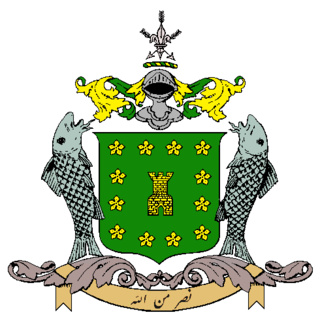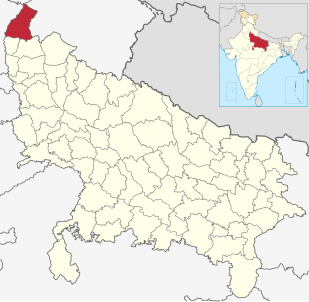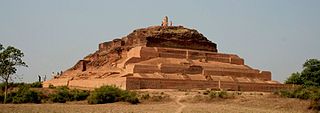
Nawab also spelt Nawaab, Navaab, Navab, Nowab, Nabob or Nobab, was a Royal indicating a sovereign ruler often of a south Asian state, in many ways comparable to the western title of King, the relationship of a Nawab to the Emperor of India has been compared to that of the King of Saxony to the German Emperor. In earlier time the title was ratified and bestowed by the reigning Mughal emperor to semi-autonomous Muslim rulers of subdivisions or princely states in the Indian subcontinent loyal to the Mughal Empire i.e. Nawabs of Bengal. The title is common among Muslim rulers of South Asia as an equivalent to the title Maharaja, however it is not exclusive to Muslims only.
Rohillas are a community of Pashtun ancestry, historically found in Rohilkhand, a region in the state of Uttar Pradesh, India. It forms the largest Pashtun diaspora community in India, and has given its name to the Rohilkhand region. The Muslim Rohillas are identified as Pathans, where as the Hindu Rohillas regard themselves as Rajput.

The Nawabs of Bhopal were the Muslim rulers of Bhopal, now part of Madhya Pradesh, India. The nawabs first ruled under the Mughal Empire from 1707 to 1737, under the Maratha Empire from 1737 to 1818, then under British rule from 1818 to 1947, and independently thereafter until it was acceded to the Union of India in 1949. The females nawabs of Bhopal held the title Nawab Begum of Bhopal.

The Bareilly districtpronunciation (help·info) belongs to the state Uttar Pradesh in northern India. Its capital is Bareilly city and it is divided in six administrative division or tehsils: Aonla, Baheri, Bareilly city, Faridpur, Mirganj, and Nawabganj. The Bareilly district is a part of the Bareilly Division and occupies an area of 4120 km² with a population of 4,448,359 people according to the census of 2011.

Saharanpur district is the northernmost of the districts of Uttar Pradesh state, India. Bordering the states of Haryana, Himachal Pradesh and Uttarakhand, and close to the foothills of Shivalik range, it lies in the northern part of the Doab region. It is primarily an agricultural area.

Bhopal State was a tributary state in 18th-century India, a princely salute state with 19-gun salute in a subsidiary alliance with British India from 1818 to 1947, and an independent state from 1947 to 1949. Islamnagar was founded and served as the State's first capital, which was later shifted to the city of Bhopal.

Ali Muhammad Khan was a Rohilla chief who succeeded his foster father Sardar Daud Khan Rohilla at the age of fourteen and eventually went on to found the Kingdom of Rohilkhand in the northwestern region of the Uttar Pradesh state of India and was generally regarded as non-oppressive ruler to the masses. He was well regarded for his political ability, and was granted the right to use India's highest insignia of the Mahseer by the Emperor Muhammad Shah. His young death along with the tender age of his children led to Hafiz Rehmat Khan's regency which was in large part governed against his wishes, despite Rehmat Khan's solemn oath on the Quran to fulfil dying Ali Mohammad's will. On his death the disenfranchisement and neglect of his sons by Rehmat Khan caused one son, Allah Yar Khan to die of consumption, and another son Murtaza Khan to leave for Secunderabad where he too would eventually die.

Alakozai is the name of a Pashtun tribe in Afghanistan. Spelling variations include Alakoozi, Alekozai, Alekuzei, Alikozai, Alokozay, Alokozay, Alkozai, Alokzai, Hulakozai, Alecozay, Alikusi, and Alakuzei.

Rampur State was a 15 gun-salute princely state of British India. It came into existence on 7 October 1774 as a result of a treaty with Oudh. Following independence in 1947, Rampur State and other princely states of the area, such as Benares and Tehri-Garwal were merged into the United Provinces. Rampur state had its capital in Rampur city and its total area was 945 sq miles.

Lieutenant Colonel Saeed ul-Mulk Nawab Sir Muhammad Ahmad Said Khan, Nawab of Chhatari also generally referred to as Nawab of Chhatari was Governor of the United Provinces, Chief Minister of United Provinces, President of the Executive Council of the Nizam of Hyderabad and Chief Scout of India.

According to the epic Mahābhārata, Bareilly region (Panchala) is said to be the birthplace of Draupadi, who was also referred to as 'Panchali' by Kṛṣṇā. When Yudhishthira becomes the king of Hastinapura at the end of the Mahābhārata, Draupadi becomes his queen. The folklore says that Gautama Buddha had once visited the ancient fortress city of Ahicchattra in Bareilly. The Jain Tirthankara Parshva is said to have attained Kaivalya at Ahichhatra.

Nawab Sayyid Hassan Ali Khan Barha, also known as Nawab Sayyid Mian II, Abdullah Khan II, was one of the Sayyid Brothers, and a key figure in the Mughal Empire under Farrukhsiyar.
The line of succession to the former throne of Bhopal, among the pre-eminent Indian principalities, was, uniquely amongst the Indian princely houses, by male-preference primogeniture in the direct family line. This principle of succession was formally established by the last Nawab of Bhopal, Hamidullah Khan, upon his confirmation as ruler of Bhopal in 1926. Since his death in 1960, the identity of the present rightful claimant to the former throne remains a matter of contention, though the claim of the descendants of his second daughter Sajida Sultan has been recognised by the Indian government and courts. As the Indian government has discontinued the official recognition of princely families since 1971, however, this question has primarily been examined since then with respect to property inheritance rights.

Nawab Sayyid Abdullah Khan Bahadur Rohilla was the eldest son of Nawab Ali Muhammad Khan of Rohilkhand and succeeded in absentia to the throne of Rohilkhand and Budaun. He was deposed by the machinations of Hafiz Rehmat Khan and replaced with his younger brother, Nawab Saadullah. Afterwards, he retreated to a spiritual life of an ascetic. He eventually died fighting the British in the Rohilla War.

Nawab Sayyid Abdullah Khan Bahadur Rohilla was the third son of Nawab Ali Muhammad Khan of Rohilkhand and succeed his brother to the throne of Rohilkhand.

The Kingdom of Rohilkhand was a powerful Indian State that arose under the declining Mughal Empire in 1721 and continued to exist until 1774 when annexation by the British transformed it into the Princely State of Rampur. Nawab Ali Mohammed Khan, a scion of the ancient Barha Dynasty became the first Nawab of Rohilkhand, having been previously elected as overlord by various Afghan Chiefs at the age of fourteen. He would carve out the future kingdom from the collapsing Mughal Empire and go on the found the Rohilla Dynasty. The crown would go on being held by the Rohillas until the kingdom came to an end in 1774, and thereafter the same dynasty would rule over Rampur.

The Rohilla Dynasty is an Indian dynasty of Arab origin that ruled Rohilkhand, and later the Princely State of Rampur. At its height, the dynasty ruled Kumaon and Imperial viceroyalty of Punjab, an area comparable in size to Germany, Denmark and Austria. With their borders reaching the edge of Delhi the dynasty had almost complete control over the affairs of the Indian Emperors.

The Barha Dynasty, is an Indian Muslim dynasty of claimed Sayyid origin, descending from the 7th Century AD Caliph, Ali. Ali himself was a descendant of Adnan a vassal and contemporary of the famous 7th Century BC Babylonian Emperor Nebuchadnezzar II. Adnan as an Ishmaelite traced his descent back to Ishmael and therefore the Barha Dynasty traces its ancestry back to the Biblical Prophet Abraham through his eldest son Ishmael. It is among the largest and oldest royal houses in India and the world, and consists of Abdullah al Wasiti, the founder of the dynasty, and his male-line descendants, who ruled in South Asia from their arrival at the close of the 10th Century until the second half of the 20th Century. When the abolition of Indian Princely States including the Princely State of Rampur ruled by the Rohilla branch of the Barha Dynasty brought their rule to an end.













